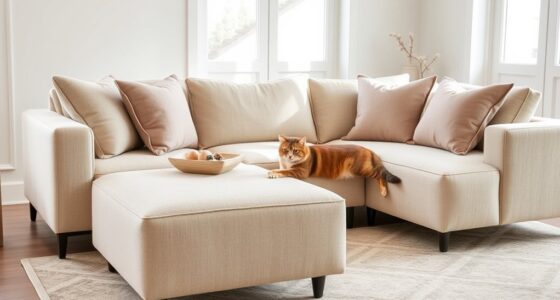Fabrics with UV protection technology are your best choice for shielding both your skin and décor from harmful rays. These textiles are specially engineered to absorb or reflect UV rays, providing high UPF ratings for extended outdoor wear and long-lasting protection. Eco-friendly options made from sustainable materials add an extra layer of conscious living. To learn how these fabrics combine durability, style, and safety, explore further and discover how they can benefit your lifestyle.
Key Takeaways
- UV protection fabrics incorporate special technology to block harmful UV rays, safeguarding skin and extending textile lifespan.
- These fabrics are made from sustainable materials and treated with natural agents, promoting eco-friendly sun protection.
- Suitable for outdoor clothing, accessories, and home décor, they prevent fading and deterioration caused by sun exposure.
- High UPF-rated fabrics provide long-lasting UV defense that remains effective after multiple washes.
- Combining UV-blocking technology with eco-conscious materials supports both skin safety and environmental sustainability.

When spending time outdoors, protecting your skin from harmful UV rays is essential, and choosing the right fabrics can make a significant difference. Not all textiles offer the same level of protection, but fabrics infused with UV protection technology can block harmful rays effectively. These fabrics are specially engineered to absorb or reflect UV radiation, providing a physical barrier that helps prevent skin damage. When shopping for outdoor clothing or accessories, look for options labeled with high UPF (Ultraviolet Protection Factor) ratings, as these indicate the fabric’s ability to block UV rays. Many of these fabrics incorporate UV protection technology during manufacturing, ensuring long-lasting defense even after multiple washes. This makes them a reliable choice whether you’re heading to the beach, hiking, or simply enjoying a sunny day in your backyard.
Protect your skin with UV-protective fabrics that block harmful rays and maintain effectiveness through multiple washes.
In addition to performance, eco-friendly fabric options are gaining popularity among consumers who want to protect both their skin and the environment. Many eco-friendly fabrics are made from sustainable materials like organic cotton, hemp, or recycled fibers, which reduce the environmental footprint of production. Some eco fabrics are treated with natural UV-blocking agents or dyes that do not contain harmful chemicals, aligning with eco-conscious values. Choosing these options allows you to enjoy outdoor activities while supporting sustainable practices. Not only do these fabrics help shield you from UV rays, but they also contribute to reducing pollution and conserving resources.
When selecting fabrics for outdoor use or even for home décor, such as curtains or upholstery, consider those with built-in UV protection technology. These textiles can extend the life of your belongings by resisting fading and deterioration caused by prolonged sun exposure. For clothing, lightweight and breathable fabrics with UV protection technology are ideal, as they keep you comfortable while shielding your skin. For home décor, UV-resistant fabrics help preserve colors and textures over time, maintaining a fresh look and reducing the need for frequent replacements. Additionally, understanding the contrast ratio of fabrics can help you choose textiles that maintain their color integrity and vibrancy after sun exposure.
Ultimately, integrating UV protection technology into your fabric choices provides an extra layer of defense against the sun’s damaging rays. Pairing this with eco-friendly options ensures you’re making mindful decisions that protect your skin and the planet. Whether you’re dressing for outdoor adventures or selecting fabrics for your living space, prioritizing UV-blocking, sustainable textiles empowers you to enjoy the sun safely and responsibly.
Frequently Asked Questions
How Do Uv-Blocking Fabrics Compare in Durability Over Time?
When comparing UV-blocking fabrics, you’ll find that their fabric longevity and fading resistance vary based on material quality and treatment. Higher-quality fabrics tend to maintain their protective features longer, resisting fading and damage from sun exposure over time. You should choose fabrics with proven durability, ensuring they stay effective and look good longer. Proper care and cleaning also help preserve their UV-blocking properties and extend their lifespan.
Are Uv-Blocking Fabrics Safe for Sensitive Skin?
You might wonder if UV-blocking fabrics are safe for sensitive skin. Generally, they are, especially if made with hypoallergenic materials. Look for fabrics that use natural fibers or avoid harsh chemical treatments, as these can cause irritation. Always check product labels to verify the fabric is free from dyes or chemicals that might trigger sensitivities. When in doubt, test a small area first to see how your skin responds.
Can Uv-Protective Fabrics Be Washed Without Losing Effectiveness?
Did you know that proper fabric maintenance can extend a textile’s UV protection? UV-protective fabrics generally retain their effectiveness after washing, especially if treated with durable textile treatments. However, frequent washing or harsh detergents might diminish their UV-blocking properties over time. To guarantee lasting protection, follow manufacturer care instructions carefully, and opt for gentle detergents designed for delicate fabrics. This way, you keep your UV-protective fabrics effective longer.
What Are the Best Decorative Options Using Uv-Blocking Textiles?
You can choose UV blocking curtains or decorative window films to enhance your space. UV blocking curtains add style while shielding your furniture from sun damage, and they’re easy to update with different fabrics or patterns. Decorative window films offer a sleek, modern look and are simple to install on windows. Both options protect your décor from UV rays and add a personalized touch to your home.
How Do Different Colors Affect UV Protection Levels?
Think of fabric pigmentation as armor for your skin and decor — darker colors act like a shield, absorbing more UV rays. Color influence on UV protection varies; darker hues, like navy or black, typically block more UV than lighter shades. Bright, pastel fabrics allow more rays through, offering less protection. So, choosing deeper colors enhances UV defense, making your textiles both stylish and functional in safeguarding against harmful rays.
Conclusion
Now that you know fabrics can block UV rays and protect both your skin and décor, you might think it’s just about practicality. But it’s also about comfort and style—balancing safety with beauty. Just as a vibrant curtain shields your space from harmful rays, it also adds a splash of color to your life. So, don’t settle for dull protection; choose fabrics that guard and inspire, turning everyday choices into powerful acts of care.









